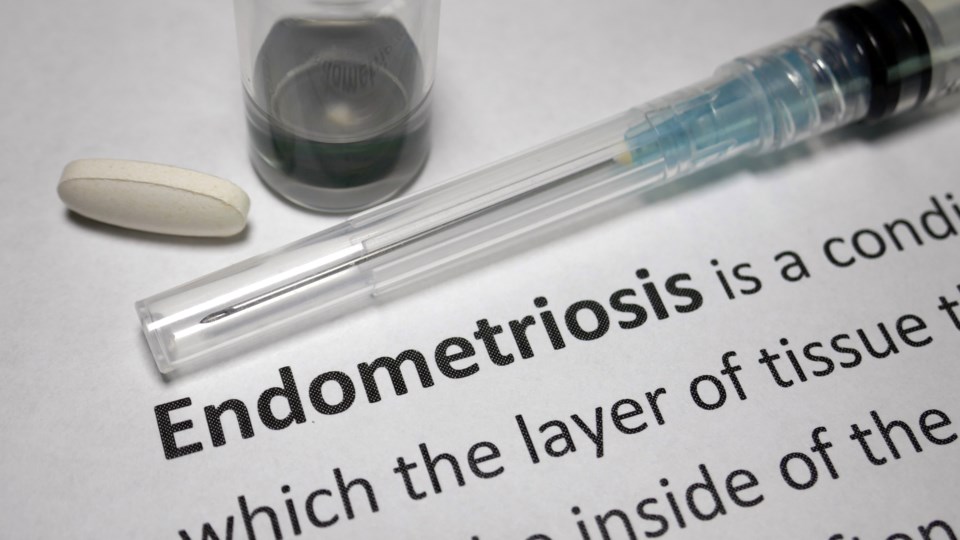Endometriosis affects an estimated 200 million people worldwide. Despite its prevalence, those living with the disease often wait an average of 7.5 years between start of symptoms and diagnosis. This delay is due to a variety of reasons, including medical dismissal, a low prioritization of the condition and its overall misrepresentation in research funding, policy and media.
Although often represented as a women’s reproductive disease, endometriosis also appears in people who have had hysterectomies, transgender men, genderfluid and non-binary people, pre-menstrual and post-menopausal people, and in rare cases, cisgender men.
Its symptoms commonly include pain with menstruation, as well as chronic pain, infertility, pain with sexual intercourse, fatigue and more. Despite this full-body impact on one’s quality of life, endometriosis is commonly associated with just having “bad periods.”
We are four authors from three countries looking at different aspects of endometriosis diagnosis, awareness and patient advocacy. This article emerges from a joint online presentation of our research looking at potential ways to improve awareness and patient care, and promote faster diagnosis.
Our methods include social scientific and qualitative research including interviews, surveys, focus groups, participant observations and collaborations with people living with endometriosis. We identified some clear changes that are needed to promote awareness of the disease, and subsequently reduce diagnostic timelines.
Widespread endometriosis education
Our research suggests that endometriosis education is severely lacking, meaning that many people who have the condition do not even know it exists.
In focus groups with 77 16- to 19-year-olds in the United Kingdom, Maria found that only 28 had heard of endometriosis before. Of these, two were able to accurately define it. Most of those who had heard of the disease had done so through friends and family, with some also hearing about it on social media or the internet. None of them had been told about it in their formal education.
Eileen’s survey of 271 people with endometriosis showed that only nine people (3.3 per cent) heard about endometriosis from grade school (elementary, junior or high school) with a few mentioning that they had heard about it briefly in nursing school.
Although Eileen’s interviews and surveys showed that social media can be very beneficial to people who live with endometriosis, Maria’s focus groups showed that social media is not very effective at reaching people who do not have the condition. People with endometriosis often put enormous amounts of work into sharing endometriosis information online, but it often does not reach the broader population.
Accurately represent menstrual pain and endometriosis pain
As Mie identifies in her fieldwork on menstruation among teenagers and interviews with endometriosis patients from Denmark, the normalization of menstrual pain is one of the main factors delaying diagnosis for people with endometriosis.
Although not everyone who has endometriosis menstruates or has menstrual pain, it is one of the most common and symptoms, and one of the earliest. Many people are encouraged to use painkillers and hormonal contraceptives to manage their pain, instead of having it investigated. Being prescribed birth control pills without a thorough investigation of symptoms, or consideration for gender identity, were also concerns identified by participants in Maria’s focus groups.
Maria’s participants also explained how they believe menstrual product advertisements undermined the severity of menstrual pain. They thought that more realistic representations of painful periods might encourage more young people with periods to seek medical help when needed.
Mie’s work identifies the often cyclical nature of endometriosis symptoms as something that can discourage patients from seeking care, as they feel their symptoms are not as extreme when they are not menstruating. Better awareness that cyclical symptoms can also indicate diseases might help patients seek care earlier.
Eileen’s social media analysis shows that people with endometriosis often use social media to represent their lived experiences of menstrual pain and endometriosis with complexity, in contrast to common media representations.
In a recent example, Amy Corfeli from the podcast and social media platform @in16yearsofendo used Instagram, Twitter and Medium to address inaccuracies in the television show Grey’s Anatomy’s representation of endometriosis. Unfortunately, Grey’s Anatomy has a larger platform, but social media pages like Amy’s, @endoQueer and @endo_black attempt to bring more nuance and diversity into the media depictions of endometriosis.
Improving diagnostic time
Endometriosis is an “invisible” condition, meaning it cannot be seen by just looking at someone. Including endometriosis in grade school curricula, covering it more extensively in medical school, and representing it more broadly in media, would help make the disease more apparent so people with symptoms seek care sooner.
However, the burden of care cannot be on patients alone, particularly for a condition like endometriosis which comes with a long history of patient-blaming. Interventions are needed on the medical side, but limited resources, long wait times, suboptimal diagnostic techniques and knowledge, and the low prioritization of endometriosis all increase diagnostic delays.
It is possible that interventions such as the FEMaLe (Finding Endometriosis using Machine Learning) project, co-ordinated by Ulrik, could help improve diagnosis in the future. This project, emerging out of Denmark, aims to develop and demonstrate a platform that uses algorithms to detect and help diagnose and treat people with endometriosis, in collaboration with their health-care providers.
In order to develop this kind of work, a multidisciplinary approach to endometriosis is needed, including not only medical research, but also the kind of qualitative work outlined in this story.
![]()
Eileen Mary Holowka receives funding from the Canadian Social Sciences and Humanities Research Council and is a member of the Endometriosis Educational Organization of Canada.
Dr. Maria Kathryn Tomlinson receives funding from the Leverhulme Trust under Grant ECF-2019-232. Her project is entitled "Menstrual Activism in the Media: Reducing Stigma and Tackling Inequalities".
Mie Kusk Søndergaard receives funding from the Danish Cancer Society and University of Southern Denmark. She has previously collaborated with the Danish endometriosis association Endometriose Foreningen.
Ulrik Bak Kirk receives funding from the EU under the H2020 Research and Innovation Action for the 'Finding Endometriosis using Machine Learning' (FEMaLe) project (grant agreement ID: 101017562).




